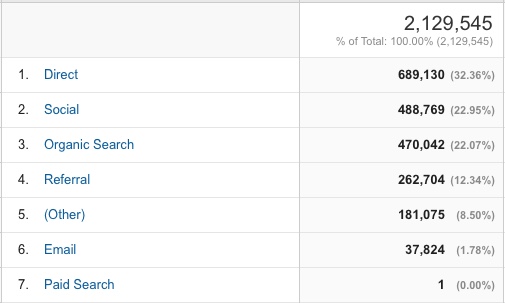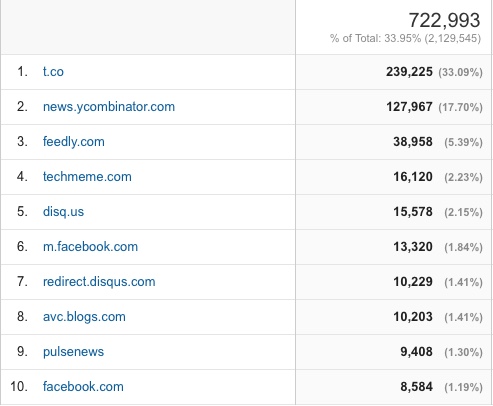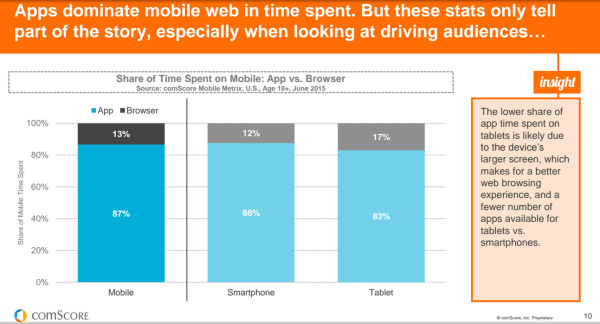Trying Something New Today
A couple days ago Jay Rosen reached out to me on Twitter asking if he could do a guest post on AVC:
@jayrosen_nyu Not normally. Why?
— Fred Wilson (@fredwilson) September 29, 2015
I really don’t like guest posts. I’ve done them, of course, mostly in my MBA Mondays series but also in times of crisis and confusion, like the time I asked JLM to explain TARP to us. So I suggested something else to Jay:
@jayrosen_nyu if you post it somewhere, send it to me, then i will blog about it and we can get the AVC community talking about it
— Fred Wilson (@fredwilson) September 29, 2015
And he delivered on it yesterday:
@fredwilson Here’s the post. Twitter is becoming an editorial company in one part of itself. https://t.co/kxOxAaYHyE Thanks for considering.
— Jay Rosen (@jayrosen_nyu) September 29, 2015
So here’s how this adaptation of the guest post concept will work.
First, I’d like you all to read Jay’s post. It’s about Twitter building an editorial team and becoming an editorial company.
Now, I will respond here at AVC.
—————————–
Twitter is a news company. It is where people go to make and break news.
That’s my line, not theirs. But I will gladly give it to them if they will use it. Because that is what Twitter is. It’s not a social network like Facebook. It’s not photo sharing app like Instagram. It’s not a messaging app like Kik. It is not a video sharing app like YouTube. It has elements of all of those things because people use Twitter in different ways. But at its core, Twitter is a news product. It reminds me more of The New York Times than Facebook and I use it more like The New York Times than Facebook. In fact, I use Twitter more than the New York Times for what I used to use the New York Times for.
But the issue with Twitter is that in order to get value out of it like I get value out of it you need to customize it. The reason I get value out of it is that I have configured Twitter to work for me. I have curated a list of just under 1000 people I follow. I like dozens of tweets a day which tells Twitter a lot about me. I reply to tweets which further tells Twitter about me. And then Twitter can recommend “who to follow” and “what I missed”. These products are fantastic and deliver for me bigtime every single day.
But imagine a new user who Twitter knows nothing about. How the hell are they going to get value out of Twitter? Or imagine the casual user who does not want to figure out who to follow and doesn’t want to engage in order to tell Twitter more about them. How the hell are they going to get value out of Twitter? The answer is Twitter the company is going to curate Twitter the news product for folks like that. And they are going to do that by hiring editors to curate various streams. This effort is called Project Lightning and that is what Jay was posting about.
So first and foremost, I am a huge fan of Twitter the company making Twitter the news product better for folks who are not power users of it. This is long overdue and badly needed. Not just for Twitter the company or Twitter the stock. It is badly needed for Twitter the product. Twitter is a network. The more people who are on it, the better it is for everyone who uses it. So addressing the new user and casual user segment of the market is something Twitter absolutely needs to do. And in full disclosure, I own a lot of Twitter the stock and I am “conflicted” in what I write here. Which is why you should pay more attention, not less, to this post.
Now on to Jay’s meta question. What editorial voice will Twitter assume? Who is the soul of Twitter’s editorial pulpit? We all know Rupert Murdoch detests Bill de Blasio so when we read negative stories about the Mayor in the NY Post, we expect it. We all know The New York Times is a “liberal rag” so when they decry Trump’s tax plan as regressive, we know where they are coming from. But where will we expect Twitter’s curation products to be coming from?
I hope Twitter doesn’t try to be “fair and balanced” also known as boring. I hope they have an agenda or ideally multiple agendas and I hope they are transparent about them. I loved Dick Costolo’s line that “Twitter is the free speech wing of the free speech party.” I hope they keep that stance. But does that conflict with bad people using Twitter to do bad things? Yes, of course it does. How will they walk that fine line? Telling us how they plan to do that would be a good first step. They can evolve it over time, but please tell us how they are thinking about it right now.
I also love Jay’s point about Jack’s obsession with raw and real-time news, like police scanners, which provided the formative idea for Twitter. I would love to see Twitter do a channel for that kind of stuff. The more real-time the better. A news product should be obsessed with the news and the more obsessive the better.
I also like Jay’s point that “it will be easy to argue with the choices Twitter makes in curating the news.” And argue they will. That’s what Twitter’s user do, right in the product. So Twitter ought to amplify that in some way or multiple ways. Having a voice, an agenda, and an attitude doesn’t mean silencing the naysayers about those things. The media outlets that amplify the naysayers seem to do better, not worse, on the Internet.
In summary, I am very bullish on a curated Twitter. I will use it and I am sure that hundreds of millions of others will too. But Jay is right that how Twitter the company curates Twitter the product will be important. It must have a voice, an agenda, an attitude, and a soul. There are many experienced people in the world of journalism who know how to deliver that. But of course, it all starts at the top. Which is why I hope they keep the team that is in place there right now. It is a good one and it is the right one.






